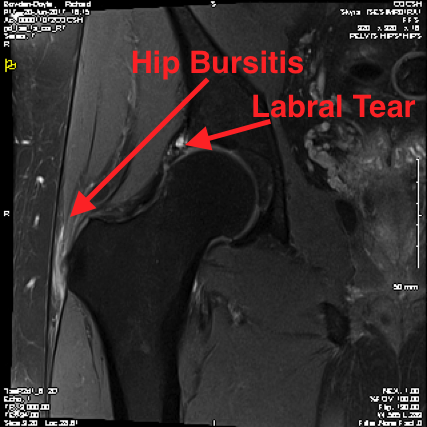Trochanteric Bursitis
Information about Trochanteric Bursitis
Trochanteric bursitis is a common disorder that affects the (lateral) side of the hip or hips. By definition, bursitis is the swelling of the bursa, a small fluid sac that releases fluid to allow for smooth motion between bones, tendons, ligaments and muscles. When the bursa becomes inflamed or swollen, problems arise and it will hurt when the bursa needs to move across a bone.
The trochanter is the hipbone formed at the end of the femoral neck (the femur bone, or thighbone). Each trochanter has a bursa on its outer side, and when one or both of those becomes inflamed, trochanteric bursitis may develop.
In addition to the hip, bursitis is frequently found in the knee, elbow and heel. Trochanteric bursitis usually strikes people when they are middle-aged or elderly.

Trochanteric Bursitis and Hip Cartilage Tear on MRI
Causes of Trochanteric Bursitis?
Overuse of the trochanteric bursa and or an inflammation of the bursa may cause trochanteric bursitis. Other possible causes of the condition include:
- A direct fall on the side of the hip
- Repetitive movements
- Prolonged or excessive pressure to the hip area (bucket car seats may aggravate the problem)
- Some infections such as staphylococcus and tuberculosis and diseases like gout and arthritis increase are associated with trochanteric bursitis
- Underlying surgical wire, implants or scar tissue in the hip area
- Differences in leg length
Symptoms of Trochanteric Bursitis?
The overriding symptom of trochanteric bursitis is pain in the thigh and trochanter area. The pain may increase over time and it may last for months, even years. The pain may be more intense when you are lying on your side.
Your doctor will need to perform a physical examination in order to diagnose the condition. It is important to rule out other sources of the pain before making a diagnosis. He or she will place pressure on the great tronchanter to see if that causes discomfort. In addition, the doctor will ask about your past medical history.
X-rays of the hip or hips may also help to confirm the diagnosis. If you suffer from other forms of bursitis or tendon disorders, your doctor may also look for another condition, in addition to trochanteric bursitis, called tendonopathy.
Treatment of Trochanteric Bursitis?
The first step in treating trochanteric bursitis is to rest the area temporarily and to decrease activity. You will want to protect the area from any further aggravation or injury by keeping pressure off the hip. In addition, your doctor may recommend:
- NSAIDs
The uses of nonsteroidal anti-inflammatory medications (NSAIDs) such as ibuprofen help decrease the pain and swelling.
- Physical therapy
Stretching exercises with a trained physiotherapist are usually helpful. Additionally, a deep massage may be performed. Icing the area will also help relieve pain.
- Injections of lidocaine and cortisone
Surgery for Trochanteric Bursitis?
Surgery is rarely recommended but may be necessary if the above conservative treatments fail to treat the condition. Usually, surgeons will only perform surgery for trochanteric bursitis if they find an obvious reason for the pain and conclude that surgery will help treat the condition. Surgery may consist of releasing the iliotibial band and removing calcified tissue. The iliotibial band is made up of a group of fibers that run along the outside of the thigh.
Trochanteric bursitis due to underlying conditions like arthritis or gout are harder to treat and may recur more frequently. Doctors recommend in these cases to avoid activities that caused the bursitis in the first place.
